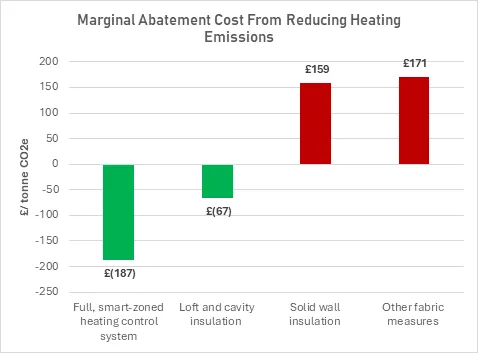What’s the Challenge?
The UK has set ambitious targets to reduce carbon emissions by 68% by 2030 compared to 1990 levels, with a commitment to reach net zero by 2050.[1] Right now, 18% of the greenhouse gas emissions come from heating our homes,[2] so to achieve these targets, it’s the cost-effective energy efficiency measures that will be crucial to reducing carbon emissions and saving money on energy bills.
Drayton by Schneider Electric have developed a marginal abatement cost curve (MACC) to compare the cost of installing heating controls against other energy efficiency measures, to help you understand the now proven importance of heating controls.
What is a MACC and What Does it Tell Us?
MACC stands for marginal abatement cost curve. The MACC compares the cost-efficiency of heating controls against other energy efficiency measures, like loft and cavity wall insulation. This illustrates the most cost-efficient ways that we can reduce carbon emissions caused by domestic heating.
What’s the Most Cost-effective Way to Increase Energy Efficiency?
Research shows that for the average UK household, a full, smart-zoned heating controls system can save £187 per tonne of CO2e (emitted CO2) abated[3]. This means that the system not only reduces CO2e emissions but also creates significant bill savings over its lifetime thanks to its short payback period.
This makes a full, smart-zoned heating controls system one of the most cost-efficient ways to cut carbon emissions – even more cost-efficient than loft and cavity insulation, which also save money while reducing carbon emissions.
How Do Other Options Compare?
Solid wall insulation and other fabric measures by comparison produce a positive MAC, meaning that it costs more money to reduce carbon emissions using these technologies. As heating controls reduce energy costs while cutting down carbon emissions, they are the cheapest alternative low carbon technology that can deliver carbon savings for consumers, when compared amongst the options considered.

A marginal abatement cost curve demonstrating that a full, smart-zoned heating system represents the best energy efficiency for its setup cost, when compared to loft and cavity insulation, solid wall insulation and other fabric insulation measures.
What is a Full Smart-zoned Heating Control System?
A full smart-zone heating control system includes a Timer, Smart Thermostat and Thermostatic Radiator Valves (TRV). The Wiser system combines smart features with an easy-to-use app and offers complete room-by-room control, so the energy use in each room can be tailored to suit the needs of the household.
Are Heating Controls the Best Retrofit Measure?
The MACC shows that heating controls offer an affordable option for reducing both energy bills for consumers and reducing carbon emissions and are quick and easy to install with minimal disruption.
Heating controls provide immediate benefits in terms of energy efficiency and cost savings, and contribute to positive behaviour change, empowering users to monitor and adjust their energy use more easily. This behavioural aspect is key to maximising effectiveness of energy efficiency measures, as well as meeting crucial net zero targets.
[1]PM recommits UK to Net Zero by 2050 and pledges a “fairer” path to achieving target to ease the financial burden on British families - GOV.UK (www.gov.uk)
[2]Decarbonising home heating (Summary) (nao.org.uk)
[3] Assumptions: 30% average energy savings from Drayton’s products; 15 year lifetime of Drayton’s heating controls; Cost of Drayton’s heating controls for timer, thermostat and TRVs; Average UK gas consumption for heating (source, search 'breakdown of a bill'); Average gas prices from DESNZ (source, table 1-19 (Oct 2023 version).
Related Reading
Drayton stockists near you
Are you an installer?
Check out Drayton Rewards+, our new and improved loyalty scheme that gives you more. Sign up free now to start earning points and access free training!
Sign up today

